A receding hairline is a common concern for both men and women, impacting self-esteem and prompting a search for effective solutions. While it is a natural part of the aging process for some, various factors can contribute to a receding hairline. In this comprehensive article, we will explore the diverse causes behind receding hairlines, shedding light on the triggers and potential preventive measures.
1. Genetic Predisposition
One of the primary factors contributing to a receding hairline is genetics. Hereditary factors play a significant role in determining whether an individual is predisposed to male or female pattern baldness. If either of your parents experienced a receding hairline, there’s a higher likelihood that you may inherit this trait. Understanding your genetic history can provide insights into your susceptibility to a receding hairline.
See Also: Protect Hairline: 12 Strategies To Prevent Frontal Baldness
2. Hormonal Changes
Hormonal fluctuations can significantly impact hair growth patterns, and a receding hairline may be a consequence of hormonal changes. In men, the hormone dihydrotestosterone (DHT) is a key player in male pattern baldness. An excess of DHT can lead to the miniaturization of hair follicles, resulting in a receding hairline. Women may experience hormonal shifts during pregnancy, menopause, or conditions like polycystic ovary syndrome (PCOS), all of which can contribute to hairline recession.
3. Age-related Hair Loss
Aging is an inevitable factor that can influence hair growth. As individuals age, hair follicles may become less active, leading to thinning and a receding hairline. This type of hair loss is often more pronounced in men, but women can also experience age-related hair thinning and recession. Understanding that aging is a natural contributor to hair changes can help individuals manage expectations and explore appropriate solutions.
4. Poor Scalp Health
The health of your scalp is integral to the vitality of your hair. Conditions such as dandruff, psoriasis, or dermatitis can compromise the health of the scalp, potentially leading to a receding hairline. It’s essential to address scalp issues promptly through proper hygiene and, if necessary, consult a dermatologist for targeted treatment. A healthy scalp provides a conducive environment for robust hair growth.
5. Excessive Styling and Traction Alopecia
Certain hairstyles that involve tight pulling or constant tension on the hair, such as tight ponytails, braids, or cornrows, can contribute to a receding hairline. This condition, known as traction alopecia, results from the stress placed on the hair follicles. Over time, repeated tension can lead to hairline recession. Opting for looser hairstyles and minimizing the use of tight hair accessories can help prevent traction alopecia.
6. Nutritional Deficiencies
The role of nutrition in maintaining healthy hair cannot be overstated. Deficiencies in essential vitamins and minerals, such as iron, zinc, vitamin D, and B-vitamins, can contribute to hair loss and a receding hairline. A well-balanced diet that includes a variety of nutrients is crucial for promoting overall hair health. Consider consulting with a healthcare professional to address nutritional deficiencies and incorporate supplements if needed.
7. Environmental Factors and Pollution
Exposure to environmental pollutants and harsh chemicals can adversely affect hair health. Air pollution and exposure to harmful chemicals in hair care products can contribute to hair loss and a receding hairline. Protecting your hair from environmental stressors, using sulfate-free and gentle hair care products, and maintaining good overall hygiene can mitigate the impact of external factors on your hair.
8. Medical Conditions
Certain medical conditions can trigger hair loss and contribute to a receding hairline. Conditions such as autoimmune disorders, thyroid disorders, and alopecia areata can disrupt the normal hair growth cycle. Additionally, individuals undergoing medical treatments such as chemotherapy may experience temporary hair loss. Addressing the underlying medical condition is crucial for managing and potentially reversing hair loss.
9. Stress and Emotional Factors
Psychological stress and emotional factors can manifest physically, impacting hair health. Chronic stress can lead to a condition called telogen effluvium, where hair prematurely enters the resting phase of the growth cycle, resulting in excessive shedding. Managing stress through relaxation techniques, exercise, and a healthy lifestyle can positively influence overall well-being and contribute to maintaining a healthy hairline.
Conclusion
A receding hairline can be influenced by a combination of genetic, hormonal, environmental, and lifestyle factors. Understanding the diverse causes is the first step toward adopting preventive measures and exploring suitable treatments. By addressing underlying issues, maintaining a healthy lifestyle, and seeking professional guidance when needed, individuals can take proactive steps to preserve their hairline and promote overall hair health. Embracing a holistic approach to hair care ensures that individuals can navigate the challenges of a receding hairline with knowledge and confidence.


